Common types of desserts:
Cookie 
 Its name derives from the Dutch
word "koekje" which means little cake, and arrived in the English
language via the Scots language, rather than directly from the Dutch. In
Scottish English the word denotes a small scone-like cake or bun, often
filled with cream.
Its name derives from the Dutch
word "koekje" which means little cake, and arrived in the English
language via the Scots language, rather than directly from the Dutch. In
Scottish English the word denotes a small scone-like cake or bun, often
filled with cream.
Cookies were first made from little pieces of cake batter that were
cooked separately in order to test oven temperature. The ancestor of the
cookie is said to have come from Persia (from the Persian kooluchih) in
the 7th century according to many sources.
Recipe
Cookies can be baked until crisp or just long enough that they remain
soft, depending on the type of cookie. Some cookies are not cooked at
all. Cookies are made in a wide variety of styles, using an array of
ingredients including sugars, spices, chocolate, butter, peanut butter,
nuts or dried fruits.
A general theory of cookies may be
formulated this way. Despite their descent from cakes and other
sweetened breads, the cookie in almost all its forms has abandoned water
as a medium for cohesion. Water in cakes serves to make the base (in the
case of cakes called 'batter') as thin as possible, which allows the
bubbles – responsible for a cake's fluffiness – to form better. In the
cookie the agent of cohesion has become some variation of the theme of
oil. Oils, be they in the form of butter, egg yolks, vegetable oils or
lard are much more viscous than water and evaporate freely at a much
higher temperature than water. Thus a cake made with butter or eggs
instead of water is far denser after removal from the oven.
Oils in baked cakes do not behave as water in the finished product.
Rather than evaporating and thickening the mixture, they remain,
saturating the bubbles of escaped gasses from what little water there
might have been in the eggs, if added, and the carbon dioxide released
by heating the baking powder. This saturation produces the most
texturally attractive feature of the cookie, and indeed all fried foods:
crispness saturated with moisture (namely oil) that does not sink into
it.
Obviously there is some variation in that some cookies are purposely
undercooked to retain a water-moist center.
Also of course there are many types of cookies and so not all are made
in the same manner.
Cookies are broadly classified
according to how they are formed, including at least these categories:
-
Drop cookies are made from a
relatively soft dough that is dropped by spoonfuls onto the baking
sheet. During baking, the mounds of dough spread and flatten.
Chocolate chip cookies are an example of drop cookies.
-
Refrigerator cookies are made
from a stiff dough that is refrigerated to become even stiffer. The
dough is typically shaped into cylinders which are sliced into round
cookies before baking.
-
Molded cookies are also made
from a stiffer dough that is molded into balls or cookie shapes by
hand before baking. Snickerdoodles are an example of molded cookies.
-
Rolled cookies are made from a
stiffer dough that is rolled out and cut into shapes with a cookie
cutter. Gingerbread men are an example.
-
Pressed cookies are made from
a soft dough that is extruded from a cookie press into various
decorative shapes before baking. Spritzgebäck are an example of a
pressed cookie.
-
Bar cookies consist of batter
or other ingredients that are poured or pressed into a pan
(sometimes in multiple layers), and cut into cookie-sized pieces
after baking. Brownies are an example of a batter-type bar cookie,
while Rice Krispie treats are a bar cookie that doesn't require
baking, perhaps similar to a cereal bar. In British English, bar
cookies are known as "tray bakes".
Cake
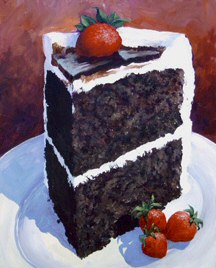 A cake is a form
of food, usually sweet, often baked. Cakes normally combine some kind of
wheat by product, a sweetening agent (commonly sugar), a binding agent
(generally egg, though gluten or starch are often used by vegetarians
and vegans), fats (usually butter or margarine, although a fruit puree
can be substituted to avoid using fat), a liquid (milk, water or fruit
juice), flavours and some form of leavening agent (such as yeast or
baking powder).
A cake is a form
of food, usually sweet, often baked. Cakes normally combine some kind of
wheat by product, a sweetening agent (commonly sugar), a binding agent
(generally egg, though gluten or starch are often used by vegetarians
and vegans), fats (usually butter or margarine, although a fruit puree
can be substituted to avoid using fat), a liquid (milk, water or fruit
juice), flavours and some form of leavening agent (such as yeast or
baking powder).
Cake is often
the dessert of choice for meals at ceremonial occasions, particularly
weddings or birthday parties. In some traditions the bride and
bridegroom are the first to eat their wedding cake, often serving each
other a piece in their fingers. For birthdays, a frosted (iced) cake,
often with inscriptions in frosting and figural decorations, is covered
with candles, which are blown out after the celebrant makes a wish. Cake
is considered delicious in many cultures.
Crumb
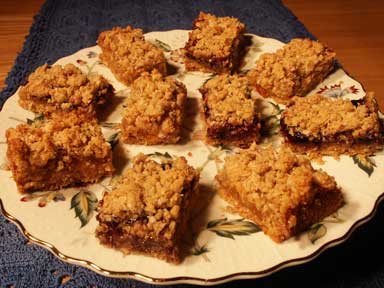
A crumble is a dish
of typically British origin containing stewed fruit topped with a
crumbly mixture of fat, flour, and sugar. The crumble is baked in an
oven until the topping is crisp. It is often served with custard, cream
or ice cream as a hearty, warm close to a meal.
Popular fruits used
in crumbles include apple, blackberry, peach, rhubarb, and plum.
Sometimes sour milk (vinegar and milk) is added to give the crumble a
more extravagant taste. Also, brown sugar is often sprinkled over the
crumble topping.
A similar dish,
without sugar, can be made with a filling of minced beef or lamb.
Custard
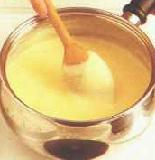 Custard is a family
of preparations based on milk and eggs, thickened with heat. Most
commonly, it refers to a dessert or dessert sauce, but custard bases are
also used for quiches and other savoury foods.
Custard is a family
of preparations based on milk and eggs, thickened with heat. Most
commonly, it refers to a dessert or dessert sauce, but custard bases are
also used for quiches and other savoury foods.
As a dessert, it is
made from a combination of milk or cream, egg yolks, sugar, and
flavourings such as vanilla. Sometimes flour, corn starch, or gelatin
are also added. In French cookery, custard—confusingly called just
crème—is never thickened in this way: when starch is added, it is pastry
cream crème pâtissière; when gelatin is added, it is crème anglaise
collée.
Depending on how
much egg or thickener is used, custard may vary in consistency from a
thin pouring sauce (crème anglaise), to a thick blancmange like that
used for vanilla slice or the pastry cream used to fill éclairs.
Custard is an
important part of dessert recipes from many countries, including the
United Kingdom, France, Portugal, Spain, Italy, and Australia.
Instant and
ready-made 'custards' are also marketed, though they are not true
custards if they are not thickened with egg.
Custard thickened
with starch is a non-Newtonian fluid which in short means that if
impacted with sufficient force it behaves more like a solid than a
liquid.
Method
For a basic dessert
custard, whisk 1/4 cup sugar with 4 egg yolks until pale yellow and
thick enough to form a slowly dissolving ribbon when lifted. Then add 1
1/2 cups cream that has been brought to a boil, very slowly and mixing
continually. Set over moderate heat (no more than 75 degrees Celsius),
and stir continually until it thickens.
Most custard is
cooked in a double boiler (bain-marie) or heated very gently on the
stove in a saucepan, but custard can also be steamed or baked in the
oven with or without a hot water bath.
Recipes
involving sweet custard include:
Fruit 
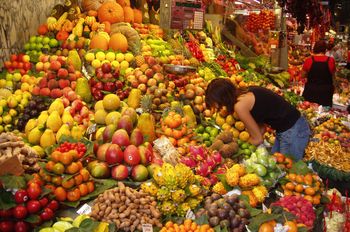
Gelatin
desserts 
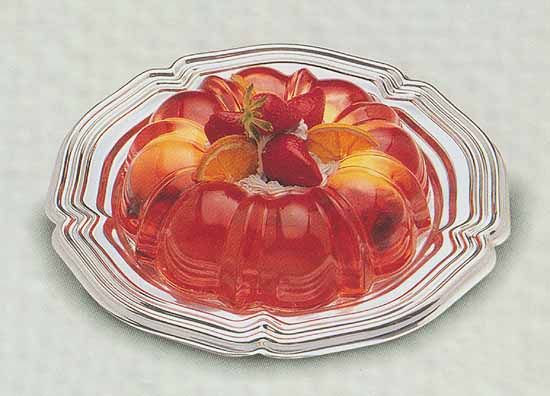 By far the most
popular use for gelatin products is as gelatin dessert. In the United
Kingdom, Australia and South Africa gelatin desserts are referred to as
jelly, and in the United States and Canada (where "jelly" is a clear
preserve stiffened by pectin and spread on bread) by its trademarked
name, Jell-O. Gelatin for desserts is marketed as a flavored powder and
sometimes in the form of loosely attached cubes, resembling a wobbly
block. Popular brands include Jell-O from Kraft Foods in North America,
Rowntree's Jelly in the United Kingdom and Aeroplane Jelly in Australia.
By far the most
popular use for gelatin products is as gelatin dessert. In the United
Kingdom, Australia and South Africa gelatin desserts are referred to as
jelly, and in the United States and Canada (where "jelly" is a clear
preserve stiffened by pectin and spread on bread) by its trademarked
name, Jell-O. Gelatin for desserts is marketed as a flavored powder and
sometimes in the form of loosely attached cubes, resembling a wobbly
block. Popular brands include Jell-O from Kraft Foods in North America,
Rowntree's Jelly in the United Kingdom and Aeroplane Jelly in Australia.
Ice
cream 
Ice cream
(originally iced cream) is a frozen dessert made from dairy products
such as cream (or substituted ingredients), combined with flavourings
and sweeteners. This mixture is cooled while stirring to prevent large
ice crystals from forming. Although the term "ice cream" is sometimes
used to mean frozen desserts and snacks in general, it is usually
reserved for frozen desserts and snacks made with a high percentage of
milk fat. Frozen custard, ice milk, sorbet and other similar products
are often also called ice cream. Governments often regulate the use of
these terms based on quantities of ingredients.
Meringue 
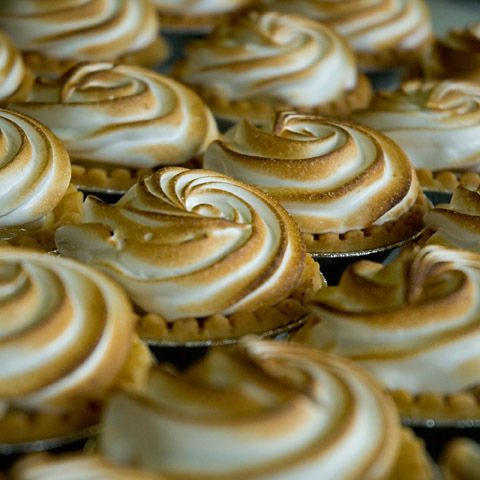 Meringue is a type of dessert, originally from France, made from whipped
egg whites and caster sugar. Some meringue recipes call for adding a
binding agent such as cream of tartar. Meringues are often flavoured
with a small amount of essence, e.g., almond or coconut. They are very
light and airy and extremely sweet. It is believed that Meringue was
invented in the Swiss town of Meiringen by an Italian chef named
Gasparini (legend varies in regard to the date of invention, between
1600 and 1720).
Meringue is a type of dessert, originally from France, made from whipped
egg whites and caster sugar. Some meringue recipes call for adding a
binding agent such as cream of tartar. Meringues are often flavoured
with a small amount of essence, e.g., almond or coconut. They are very
light and airy and extremely sweet. It is believed that Meringue was
invented in the Swiss town of Meiringen by an Italian chef named
Gasparini (legend varies in regard to the date of invention, between
1600 and 1720).
Meringues used
like cookies are baked at a very low heat for a long time - they are not
supposed to be browned at all, but they need to be very crisp and dry.
Cooked meringue cannot be refrigerated or it will become soggy. It will
keep for at least a week in an airtight container.
Meringue can be
used as the basis for various other desserts including angel food cake,
pavlova, baked Alaska, Queen of Puddings and lemon meringue pie. In
these cases, the meringue may be cooked at a higher temperature for a
shorter amount of time, resulting in a soft meringue with slightly
browned peaks on top.
Pastry 
Pastry is the name
given to various kinds of dough made from ingredients such as flour,
butter and eggs, that are rolled out thinly and used as the base for
baked goods. Common pastry dishes include pies, tarts, and quiches.
A good pastry is
light and airy, easily broken in the mouth (what is called 'short'
eating), but firm enough to support the weight of the filling. The dough
must be well mixed, but care must be taken not to overmix the pastry,
which results in long gluten strands and toughens the pastry. Thus the
manufacture of good pastry is something of a fine art.
As pastry must be
baked to be edible, and pie fillings often do not need extra baking,
many pie recipes involve blind-baking the pastry before the filling is
added.
Pie 
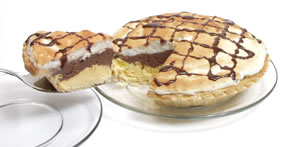 A pie is a baked
dish, with a baked shell usually made of pastry that covers or
completely contains a filling of meat, fish, vegetables, fruit, cheeses,
creams, chocolate, custards, nuts, or other sweet or savoury ingredient.
Pies can be either "one-crust," where the filling is placed in a dish
and covered with a pastry/potato mash top before baking, or "two-crust,"
with the filling completely enclosed in the pastry shell. Some pies have
only a bottom crust, generally if they have a sweet filling that does
not require cooking. These bottom-crust-only pies may be known as tarts
or tartlets. One example of a savoury bottom-crust-only pie is a quiche.
Tarte Tatin is a one-crust fruit pie that is served upside-down, with
the crust underneath. Blind-baking is used to develop a crust's
crispiness, and keep it from becoming soggy under the burden of a very
liquid filling. If the crust of the pie requires much more cooking than
the chosen filling, it may also be blind-baked before the filling is
added and then only briefly cooked or refrigerated.
A pie is a baked
dish, with a baked shell usually made of pastry that covers or
completely contains a filling of meat, fish, vegetables, fruit, cheeses,
creams, chocolate, custards, nuts, or other sweet or savoury ingredient.
Pies can be either "one-crust," where the filling is placed in a dish
and covered with a pastry/potato mash top before baking, or "two-crust,"
with the filling completely enclosed in the pastry shell. Some pies have
only a bottom crust, generally if they have a sweet filling that does
not require cooking. These bottom-crust-only pies may be known as tarts
or tartlets. One example of a savoury bottom-crust-only pie is a quiche.
Tarte Tatin is a one-crust fruit pie that is served upside-down, with
the crust underneath. Blind-baking is used to develop a crust's
crispiness, and keep it from becoming soggy under the burden of a very
liquid filling. If the crust of the pie requires much more cooking than
the chosen filling, it may also be blind-baked before the filling is
added and then only briefly cooked or refrigerated.
Pie fillings range
in size from tiny bite-size party pies or small tartlets, to
single-serve pies (e.g. a pasty) and larger pies baked in a dish and
eaten by the slice. The type of pastry used depends on the filling. It
may be either a butter-rich flaky or puff pastry, a sturdy shortcrust
pastry, or, in the case of savoury pies, a hot water crust pastry.
Pudding 
Pudding is either
of two general types of food, the second deriving from the first.
The older puddings
were foods that were presented in a solid mass formed by the
amalgamation of various ingredients with a binder, which might include
batter (as in Yorkshire pudding), blood (black pudding), eggs (bread
pudding), or a mixture of suet and flour or some other cereal (plum
pudding). These kinds of puddings could be either baked, steamed, or
boiled. This older type of pudding, still commonly made today in the
British Isles, was often a main-course type of dish. Boiled puddings, in
particular, were a common meal on board ships in the British Navy in the
18th and 19th centuries, and the usual manner in which daily rations of
flour and suet were prepared.
The newer type of
pudding is almost exclusively a dessert-type dish. The usual form is for
milk with sugar and other added ingredients to be solidified by means of
some gelling or structural agent, including cornstarch, gelatin, eggs,
tapioca (cassava), and other starches. Forms of these include custard
and blanc-mange. They are available in forms which require cooking or in
instant form. Related foods include gelatin desserts such as Jell-O and
aspics.
The Danish society
Royale Danske Buddingentusiaster (Royal Danish Pudding Enthusiasts) was
founded in 2005 and is organizing the promotion of the Danish type of
pudding, i.e. using boiled milk, sugar and starch or gelatin as the
base of flavours ranging from the classic vanilla and chocolate to the
newer tequila and ginger.
Sorbet 
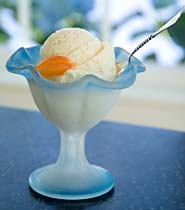 Sorbet (or
sorbetto, sorbeto) is a frozen dessert made from iced fruit puree and
other ingredients. The term "sherbet" is derived from the Turkish word
for "sorbet", şerbat.
Sorbet (or
sorbetto, sorbeto) is a frozen dessert made from iced fruit puree and
other ingredients. The term "sherbet" is derived from the Turkish word
for "sorbet", şerbat.
Sorbet is a form of
gelato that contains no milk, unlike ice cream. Sorbets may contain
alcohol (which lowers the freezing temperature, resulting in a softer
sorbet). Unlike ice cream, the machinery used whips almost no air into
the sorbet, resulting in a dense and extremely flavorful product. This
allows sorbet to match and sometimes exceed dairy-based gelato or ice
cream for taste.
Sorbets are
traditionally served between the starter course and main entrée in order
to cleanse the palate. The French are responsible for this culinary
tradition.
Folklore insists
that Nero, the Roman Emperor, invented sorbet during the first century
A.D. when he had runners along the Appian way pass buckets of snow hand
over hand from the mountains to his banquet hall where it was then mixed
with honey and wine. The Chinese have also made concoctions made from
snow, juice, and fruit pulp for several thousand years.
Frozen desserts are
believed to have been brought to France in 1533 by Catherine de Medici
when she left Italy to marry the Duke of Orleans, who later became Henry
II of France. By the end of the 17th century, sorbet was served in the
streets of Paris, and spread to England and the rest of Europe.
Sorbet is served as
a non-fat (sometimes 3% fat) and vegan alternative to ice cream.
Soufflé 
A soufflé is a
light, fluffy baked dish made with egg yolks and beaten egg whites
combined with various other ingredients and served as a main dish or
sweetened as a dessert. The word soufflé is the past participle of the
French verb souffler which means "to blow up" or more loosely "puff up"
- an apt description of what happens to this combination of custard and
egg whites.
Every soufflé is
made from 2 basic components:
The base provides
the flavor and the whites provide the "lift". Common varieties include
cheese, chocolate, and lemon (the last two made as desserts, with a good
deal of sugar).
Soufflé is
considered a great delicacy. When it comes out of the oven, a soufflé is
generally very large and fluffy, and will 'fall' after 20 or 30 minutes
(as risen dough does). For best results, soufflé should be eaten
quickly, while hot and before it falls.
Soufflé can be made
in containers of all shapes and sizes, but the best are tall cylindrical
containers which conduct heat well. It is traditional to make souffle in
"souffle cups" or ramekins.